#art history lesson
Text
The Story of Madame X

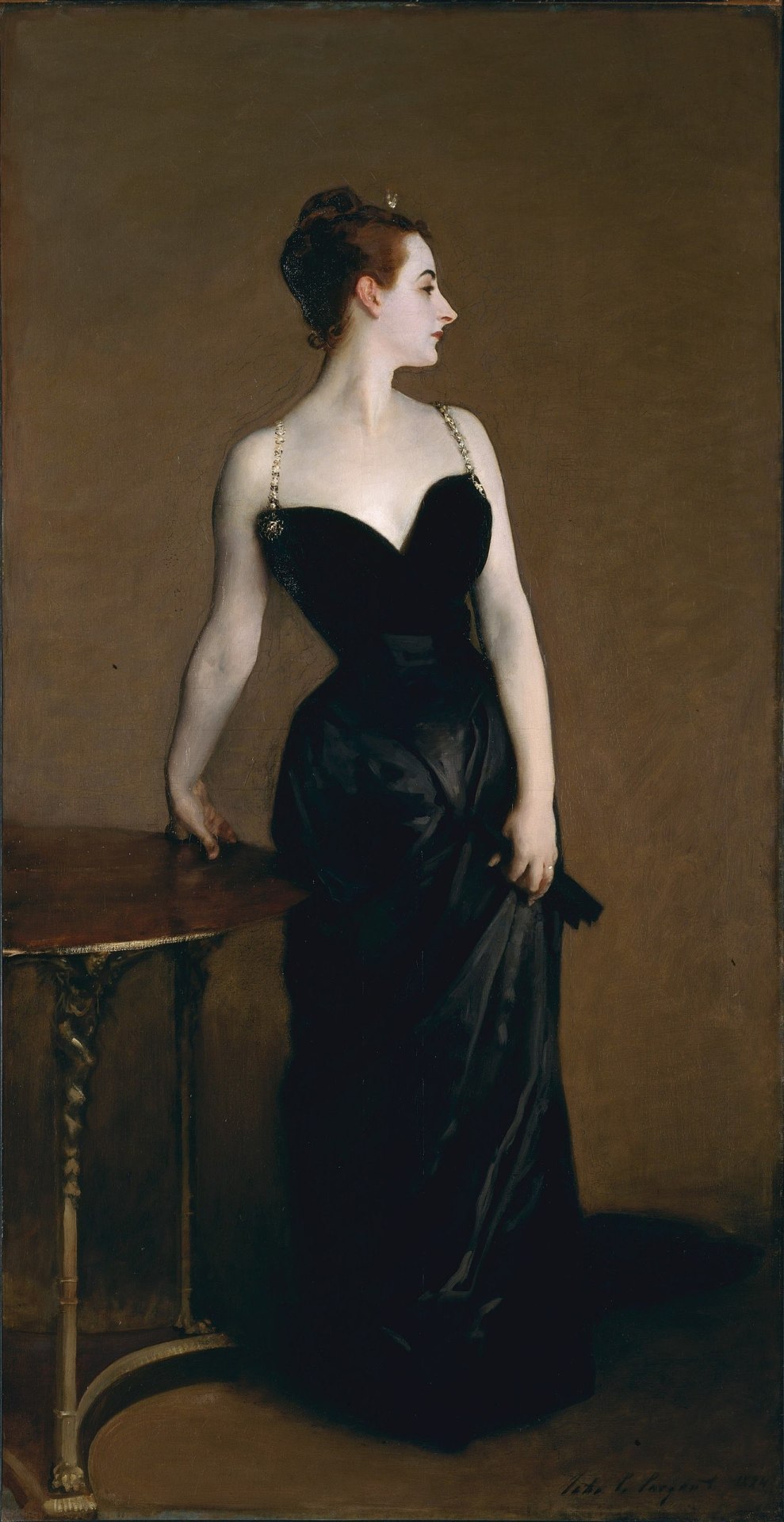

John Singer Sargent (American, 1856–1925) • Madame X (Virginie Amélie Avegno Gautreau) • 1883-84 • Metropolitan Museum of Art
Photograph of Sargent with what is perhaps his most famous portrait – that of the very wealthy socialite, Madame Gautreau. This is not the original version, though; the one that shocked the art world in 1884 when it was shown at the Paris Salon.


Above is a sketch for the Gautreau portrait. At some point Sargent decided to paint the right strap of her dress seductively off her shoulder. When the portrait was shown in Paris, there was an uproar of disapproval. Madame Gautreau was, apparently, already rumored to be an adultress. Her Singer portrait only added emphasis to the public's criticism of her character. According to the gallery card at the Museum of Fine Arts, Boston (the painting was on loan from the MET), Gautreau very much liked the painting. What neither she nor Sargent predicted was that it would cause such a stir and be the cause of much conversation, mostly derisive, in the drawing rooms of Paris high society.
Sargent was so upset by the reaction at the Salon and the ensuing buzz that he took the painting back to his studio and repainted the strap in its proper place on the shoulder.
The painting was eventually sold on the condition that its subject not be revealed in the title. It was to be called Madame X.
Sources:
Museum of Fine Arts, Boston
Metropolitan Museum of Art
Arty: Why Madame X Scandalized the Art World by Alina Cohen
#art#painting#fine art#art history#madame x#john singer sargent#american renaissance#american artist#oil painting#amélie gautreau#society portrait#portrait#female portrait#19th century art#museum of fine arts boston#metropolitan museum of art#famous paintings#pagan sphinx art blog#art history lesson
67 notes
·
View notes
Text
youtube
Art is sexy
11 notes
·
View notes
Text

The sack of Rome, August 24th 410 CE, colourised.
Art by Psicochurroz
#196#196 migration#apartmentofawesome#r/196#/r/196#historical shitposting#art history shitposting#historyposting#HISTORY LESSON INCOMING#Rome was sacked by the Visigoths in 410 C.E.#Joseph-Noel Sylvestre#depicted this in a famous painting#The Sack of Rome by the Barbarians in 410#this artist#psicochurroz#has spoofed this artwork#replacing the big beefy barbarians with cute goth girls#hope this helped! until next time
15K notes
·
View notes
Text
Tired Ghost
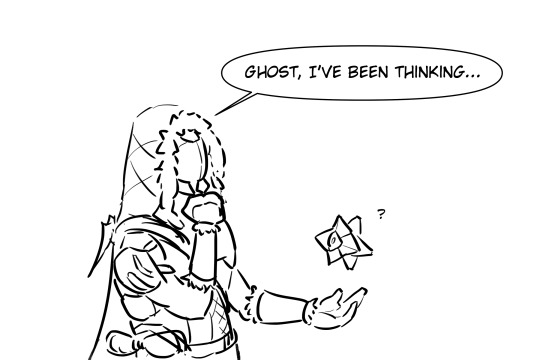




#i don't wanna spend too much time on this#(wrote an essay about how i thought vanguard hacking kit was developed)#yep that's not lorem ipsum#i just wanna see ghost complaining don't judge me too much#i didn't take history class in the ishtar collective (TM) those are all ooc don't actually read into that#if you actually know what im saying then you'd know i probably failed my computer security lesson#also the traveller probably gave them similar tech so their physical architecture should be similar#also ur a nerd lol#destiny 2#destiny hunter#destiny ghost#destiny 2 art#my art
624 notes
·
View notes
Text
Fathers as nurturers during the Napoleonic era

Portrait of Monsieur Gaudry giving his daughter a geography lesson, 1812, Louis-Léopold Boilly
The Gaudry portrait is even more a portrayal of “the good father” than a lesson in political geography. The painting provides evidence of a reorientation of the father’s role within the family that had taken place from the eighteenth to the nineteenth centuries. In her study of archetypal family structures during the Revolutionary period, Lynn Hunt traces “the rise and fall of the good father” and his eventual replacement, as an ambivalent figure, by republican fathers “who were now officially depicted as friendly, supportive, and interested in their children.” While the gradual transformation of the king into a good father began before the Revolution (as manifested in the portrait of Louis XVI, and not a tutor, instructing his son in geography), it was not until the Napoleonic period that a positive image of paternalism was explicitly rehabilitated, as Boilly’s commission for a portrait of the yet-childless Napoleon as père de famille so clearly indicates. In the meanwhile, children assumed new importance as the affective center of gravity in representations of families, a shift that is indicated by the painting’s focus on the demure Mlle Gaudry. Rather than reading the Gaudry portrait in twentieth-century terms, as an expression of “unusual sensitivity and psychological insight,” Boilly’s portrayal of an affectionate and respectful relationship between father and daughter is better understood as conforming to a new social construction of the family that came to the fore during the Napoleonic period, in which fathers assumed new roles as nurturers or guides.
Source: The Art of Louis-Léopold Boilly: Modern Life in Napoleonic France, Susan Siegfried, pp, 115
#Louis-Léopold Boilly#Boilly#The Art of Louis-Léopold Boilly: Modern Life in Napoleonic France#Susan Siegfried#Siegfried#napoleon#napoleonic era#napoleonic#napoleon bonaparte#first french empire#french empire#19th century#history#art#art history#history of art#social history#the geography lesson#geography#genre art#neoclassical#Neoclassicism#Monsieur Gaudry#France#french revolution#napoleonic France#French art#my pic#my pics
73 notes
·
View notes
Text
No one likes a mad woman

What a shame she went mad-
#morgana#morgana pendragon#morgana fanart#bbc merlin#Merlin#merlin fanart#Literally obsessed with art nouveau inspired stuff lately so heres a poster inspired by that#But featuring morgana because i need her#Who knew art history lessons could actually be useful wtf.#Hated the lessons but living for knowing stuff about art#Last art of the year yooo
718 notes
·
View notes
Text

redraw of one of my favorite omake panels
86 notes
·
View notes
Text
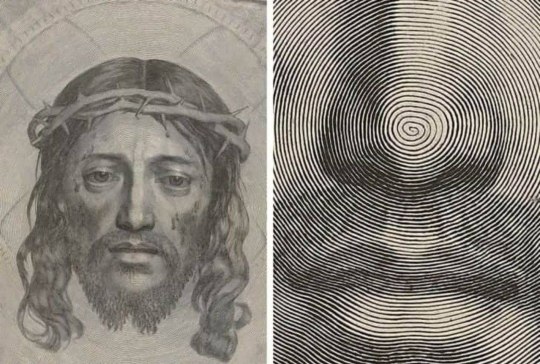
This seventeenth-century engraving of Jesus Christ wearing a crown of thorns is titled "One with a single line”
Indeed, what from a distance resembles an ordinary drawing is, up close, an image created with a single line that spirals in a spiral. All details of the face and the transitions of light and shadow are created by the thickening of this line. The author is French artist Claude Mellan.
For the artist's contemporaries, his method of engraving remained a mystery, and no one has been able to repeat it. 🤔
#pay attention#educate yourselves#educate yourself#knowledge is power#reeducate yourself#reeducate yourselves#think about it#think for yourselves#think for yourself#do your homework#do some research#do your own research#ask yourself questions#question everything#artistic#artists#art#artwork#world history#history lesson#history
69 notes
·
View notes
Text
"average person creates 3 new AUs per year" factoid actually just statistical error. average person makes 0 AUs per year. Alternate Universes Catie, who lives in cave & makes over 2 each month, is an outlier adn should not have been counted
#i think about how many ive made this year and i feel a bit woozy#its so funny bcs ive always been weirdly staunch abt not making AUs for my own characters#<- just bcs i wanna establish them and putting them in different AUs makes it a bit less stable so#and them i start drawing fanart for the first time in my life and go absolutely nuts#let me think hmm i think ive made 8 or so this year 🤔#not all of them have art yet but they do haunt me#like also does it count if you make offshoots of your own AUs 😭#i have too many thoughts ;;;;;#also i think its just bcs i really crave learning new info#and ive learned *a lot* about f1 so its fun to make AUs by learning more abt smth else and then combining them#like hmm how do these real world events fit into early 18th century europe JSKFKGLLVLV#actually i *do* live in cave. me and my dark bedroom 🤧#if you stay on my blog you WILL get a history or culture lesson abt some inane thing#catie.rambling.txt#*i need to start putting 'scheduled' in the tags of posts so you guys dont get a horrible perception of my sleep schedule#well it is horrible. but not horrible enough that im staying up *too* late
27 notes
·
View notes
Text
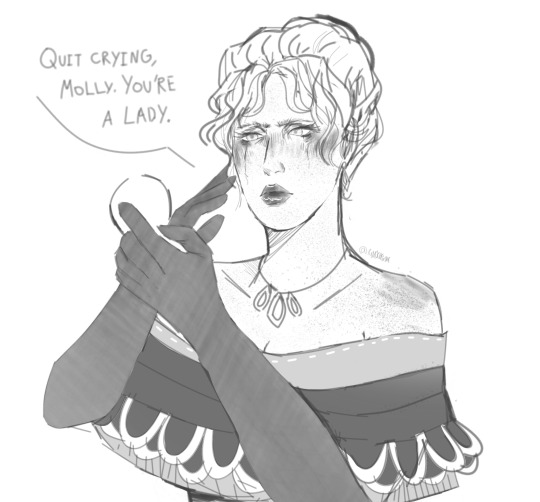
A bonus Molly sketch from my gilded cage things! Given the circumstances for Molly in particular during chapter 4 and the fact that Dutch being the way he is would likely just use her as an accessory for the evening I can’t imagine her having a good time, but at least the dress is pretty
#rdr2#molly o’shea#I’ve thought about this a lot#she would not get a second away from him I’m sure#he can’t stand her even breathing the wrong way around him at that point but having a woman with him would make him seem less suspicious#which is a big thing during that mission#so molly would just be hanging onto his arm all evening unable to go anywhere or speak to anyone by herself#I’d get into how she would also not be received well by many people there especially if she approached them alone#because she is Irish and these are a bunch of rich people and it is 1899#I have a lot to say about the importance of molly being an Irish immigrant as an Irish person myself#but I don’t feel like giving a history lesson here#so to condense my thoughts a little molly would have been stuck with Dutch the entire evening#surrounded by people who probably have an inherent dislike for her once they hear her speak#or ignore her in favour of whatever Dutch is saying#which is pretty similar to how the gang already treats her#so even once she finally leaves camp it’s just the same#there is more I could say especially regarding the dress itself but that’s too long to write here#fanart#digital art#sketches#my art
112 notes
·
View notes
Text


two EARLY early rusty pfps of mine.........these are so old it feels like they're from another dimension at this point. both are from september 2022 or so
#you can see that I clarified what I wanted from my rusty very quickly#these versions are maybe a handful of weeks apart#the left is my first colored drawing of rusty and the one on the right already features a lot of my trademarks#face rust‚ near-black base‚ no orange in the costume itself‚ red theme‚ FANGS‚ yellow eyes‚ chin shape and mullet#overall a heavy broadway / g mowry influence combined with my own headcannons#you can also see exactly how rusty's face rust eventually grew into the large path across his nose cuz i just added more every time LOL#and the old four pointed star in his eyes headcannon which i came up with on my first day into starex and eventually stopped drawing bc-#-the way i draw eyes just doesn't really allow for it#anyways. history lesson or whatever#these were both my pfp for some time but i never actually POSTED them#i can do another few posts with my pfps but probably on mus1ca1 instead bc they're lower quality from here on out#stex fanart#rusty the steam engine#stex#art or whatever
14 notes
·
View notes
Text
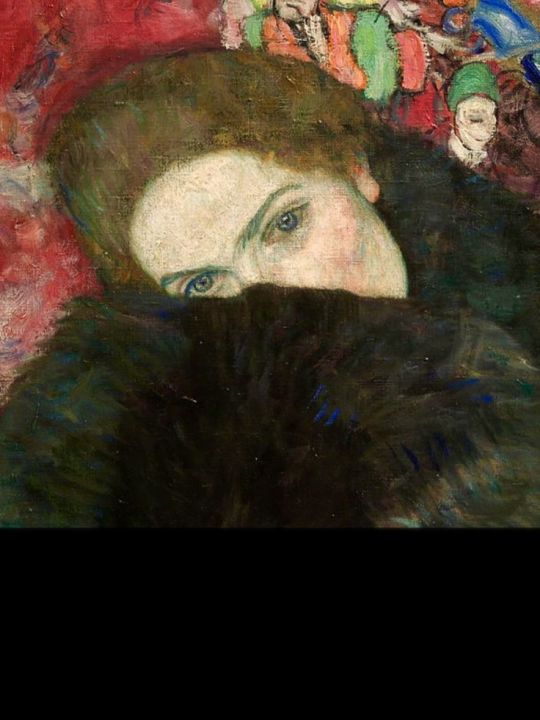
Gustav Klimt (Austrian, 1862-1918) • Dame mit Muff • 1917 • National Gallery, Prague
This Klimt painting was last displayed in Vienna in 1926. Considred lost, the painting was discovered to be in a private collection in the Czech Republic since the 1930s. In 2014, the art collector agreed to loan the painting indefinitely to the National Gallery in Prague.
“The NG has achieved something that can be called an art history dream,” Helena Musilová, director of the National Gallery’s modern and contemporary art collection, told the Prague Post. “We are often addressed by the people claiming that they have certainly an original painting, but this is often not proven,” she said. She added that it is extremely rare that a work thought to be lost resurfaces after so many decades. – Artnet News
#art#painting#fine art#art history#portrait#women in paintings#gustave klimt#austrian artist#art history lesson#national gallery prague#art nouveau#modern art#vienna secession#pagan sphinx art blog#art blogs on tumblr#art appreciation#art lovers#female portrait
31 notes
·
View notes
Text
youtube
Andrew Wyeth interview
7 notes
·
View notes
Text
Cabaret's Shifting Lead Placement
Welcome to another rambling theatre history lesson with DroughtofApathy. Today we're going to examining the fascinating history of Cabaret's ever-changing lead roles.
Ground rule: Tony eligibility for Lead Actor/Actress is first determined by "above-the-title" billing in the show's opening night Playbill. It was a far stricter guideline in the past, as you'll see. These days, many lead roles aren't put above the title (ex. Hadestown, Kimberly Akimbo, etc.) but will be placed in lead categories either because it's obviously a lead, or because producers lobby for it. Conversely, actors can have "above-the-title" billing and be in featured roles, usually because they're major names like Angela Lansbury and Elaine Stritch, who were both Madame Armfeldt in the 2009/2011 revival of A Little Night Music. In which case, producers will usually submit them as featured.
When Cabaret opened on Broadway in 1966, Jill Haworth (Sally), Jack Gilford (Herr Schultz), and Bert Convey (Cliff) got top billing with Lotte Lenya (Fraulein Schneider) in the coveted "and" slot just below. Note who's missing. That's right. When the show premiered, Joel Grey (Emcee) was just a regular old featured role.


Left: opening night playbill billing. Right: post-Tony rebilling with Joel Grey's ascension.
At the 1967 Tonys, Jack Gilford (Herr Schultz) and Lotte Lenya (Fraulein Schneider) were nominated as Leading Actor/Actress, respectively, while Joel Grey and Edward Winter (Ernst Ludwig) were both in Featured. Jill Haworth (Sally) was not nominated, but would have been eligible for Lead as she had "above-the-title" billing. At the time, Joel Grey was just another working actor. Not so after Cabaret. His performance elevated both the role and his billing, thus transforming the Emcee into a Leading Role from then on.
Subsequent productions would focus more on Sally and the Emcee, while Schultz and Schneider (and the non-singing Cliff) would become featured roles. However, the "above the title" Tony ruling was far stricter back in the day, leading Sally (this time Alyson Reed) to once more be featured in the 1987 revival.


Left: opening night Playbill billing. Right: poster billing
In 1987, Joel Grey was given the sole "above-the-title" billing with Alyson Reed in the next featured spot. Though Sally was, like 1966, technically a lead role, she was nominated in featured at the Tonys that season. (Grey was not eligible as he was reprising his role.) In this production, Regina Resnik (Schneider) and Werner Klemperer (Schultz) both got fancy featured billing and nominations in their respective categories. As Cliff, Gregg Edelman got the "and" billing, but in this case it was less elevated than either Resnik or Klemperer (note the boxes). Edelman was still early-career at this point, and not yet a "name" but Cliff was still considered an elevated role in the company.
By 1998, however, the roles as we currently think of them had finally slotted into place. Alan Cumming (Emcee) won for Best Actor, Natasha Richardson (Sally) for Best Actress and Ron Rifkin (Schultz) for Featured Actor. Mary Louise Wilson (Schneider) was nominated in Featured Actress. Richardson also received left-side billing, as she was a larger name (arguably) than Cumming at the time.

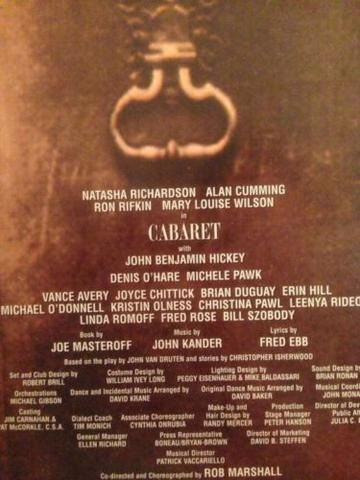
Left: opening night Playbill billing. Right: lobby poster billing
But though nominations seemed to make sense, it still didn't jive with billing placement. In the 1998 production, Richardson, Cumming, and Rifkin all had "above-the-title" with Wilson in the featured "and" slot. Despite this placement, Rifkin went in for Featured. Producers can lobby the Tony committee for actor placement if they think it fitting, and these days we're a lot more fast-and-loose with the definitions. Note however, how Wilson has "above-the-title" billing in the lobby board. This was presumably a contractual renegotiation that happened post-Tonys. Note how Denis O'Hare (Ernst) and Michele Pawk (Kost) have their own line below John Benjamin Hickey (Cliff). All three were/are modest, but known, names in the theatre world, about equal to one another, at least at the time.
By 2014, the old couple (Schultz and Schneider) no longer would get top billing. Alan Cumming only built upon Joel Grey's foundation to fully elevate the Emcee role into the undisputed leading man, with Sally the star-vehicle leading lady. Between the 1998 and up until the recent revival, the older couple's story--and Cliff's importance--had taken a backseat.
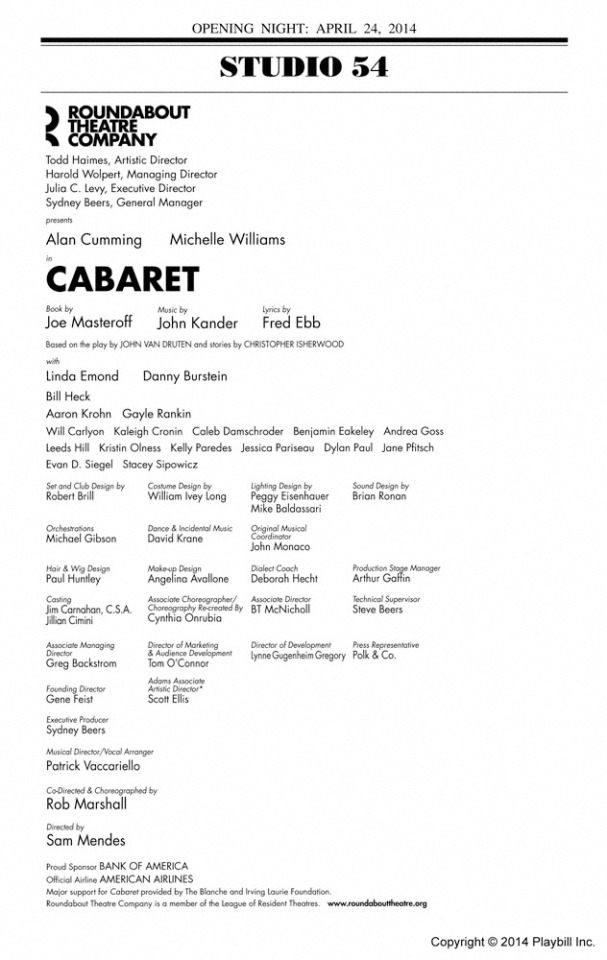

Left: opening night Playbill billing. Right: poster billing.
In 2014, the revival won no Tonys, but was nominated for both Featured Actor and Actress (Danny Burstein and Linda Emond, respectively). Cumming was not eligible as, like Joel Grey before him, he was reprising his role. This time, with a Tony in his pocket, and a much bigger name than 16 years prior, he got left-side billing. Emond and Burstein received equal line billing below the title, with Emond getting the left. Though they were roughly equal in the theatre world, and Burstein had a slight edge in terms of Tony noms, I'd guess Emond got the left owing to her larger screen presence/notoriety. In the poster, Bill Heck (Cliff) is left out of featured billing entirely, as are Aaron Krohn (Ernst) and Gayle Rankin (Kost).
Now we come to our latest revival, number four. Though it's still too early for nominations, we can assume Eddie Redmayne (Emcee) and Gayle Rankin (Sally) will be leads with all others featured. Historically, Schultz and Schneider are roles that receive nominations, and the Emcee a role that wins. Will that hold in a wildly over-crowded season?
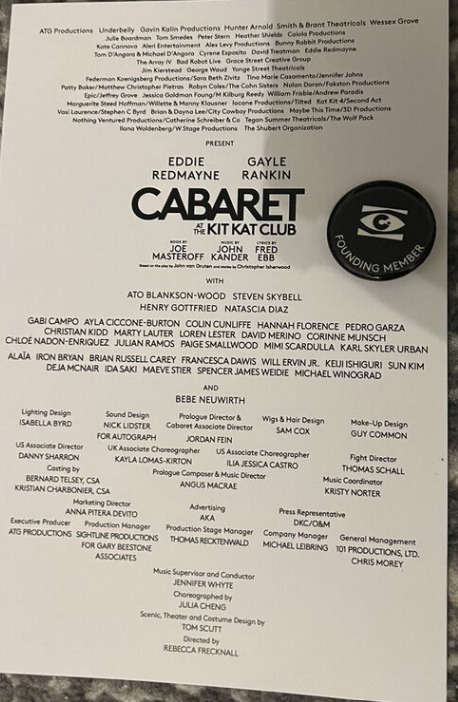

Left: first preview Playbill insert. Right: billing poster outside the theater.
Once more deviating from past productions, the roles of Cliff (Ato Blankson-Wood), Ernst (Henry Gottfried), and Kost (Natascia Diaz) are plucked back out of the company to be given featured billing. This time, Steven Skybell (Schultz) is on even footing with Cliff, even slightly under with his right-side billing. This would be the least "elevated" billing any Schultz has ever gotten. Skybell is a respected theatre veteran but not quite a household name, even in theatre circles. Blankson-Wood, meanwhile, is a recent Tony nominee. It's all politics when it comes to billing.
Here, Bebe Neuwirth (Schneider) is given the coveted "and" poster billing, no surprise. Of the featured roles, she's inarguably the biggest name. A few decades ago, that might have been enough to get her above the title, but these days it's less common that a solidly featured role would get that (unless you're Patti LuPone in Company, and Bebe doesn't have quite the same sway or ego).
This, to me, seems like the most obvious case of industry politics and agent negotiation at play, and usually actors (and egos) aren't even involved in the conversation. Skybell and Neuwirth aren't on the same level, though their characters are. My guess here is that producers want to bill their sole two-time Tony winner separately, and Skybell's agents know he isn't big enough to dispute that.

Now, let's take a look at this marketing design. Redmayne's name is left-billed despite being above Rankin's head. While annoying for those of us audience members who might just see this as a design flaw, this is all contractual, negotiated to death. Redmayne also gets front-and-center positioning, while Rankin is in the background, off-center, but she gets left-side position, which isn't as minimizing as right-side would. Left-billing is given to the bigger name because English reads left to right. These are the kinds of things I think about when I see marketing ads and playbills.
#cabaret#cabaret broadway#history lessons with doa#ask me about the sweeney todd teaser key art please it's an even better example of contracts at play#yeah i *did* stalk the ebay pages until someone put a playbill picture up for listing i'm just that dedicated to the craft#bebe neuwirth#joel grey#alan cumming#it's 9:30 a.m. but we're going live with this because why the fuck not?
15 notes
·
View notes
Text
"Crying does not indicate that you are weak. Since birth, it has always been a sign that you are alive."
- Charlotte Bronte @silentroad
#writing#poetry#tumblrpost#literature#relatable#art#dark academia#lit#quotes#im cryin#since birth#life quote#life lessons#about life#history#poets on tumblr#spilled ink
33 notes
·
View notes
Text
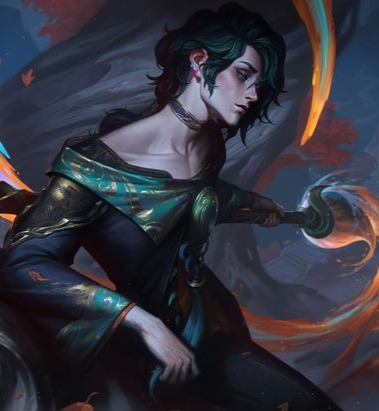

They are friends in my heart :)
#thirty something twinks of league with some weird ass yaoi going on#just on the opposite sides of a spectrum#Hwei would ask Viktor how to solve 12 x (2+6)^2#And Viktor would ask Hwei to explain how paint magic works#in bonus he would get an extended ionian art history lesson whic he didn't ask for and he probablh doesn't care but listens to anyways#cuz hes a polite boy#i need them to meet asap#txt#leage of legends#arcane viktor#lukai hwei
12 notes
·
View notes